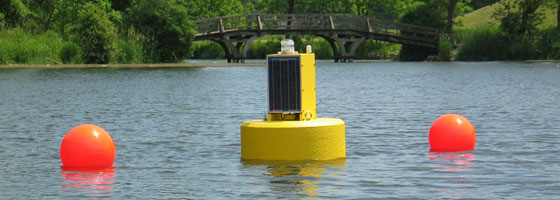Vertical Profiling of Water Quality

There are many cases when it’s beneficial to attain water quality data at multiple points throughout the water column instead of from a single depth. Vertical profiling is most commonly seen with the use of temperature strings, when sensors are placed at incremental lengths along a data cable. Beyond simple temperature measurements, however, it’s possible to profile the water column with a vast array of additional sensors.
Multi-parameter water quality sondes allow the measurement of characteristics including dissolved oxygen, pH, turbidity, depth, chlorophyll, and more. And measuring the entire water column often only requires a single sonde and set of sensors
The continuous monitoring of parameters throughout the water column helps understand how conditions in lakes, reservoirs, or other water bodies change over time, fostering a better understanding of limnological cycle aspects such as internal mixing, nutrient uptake, primary production, and community respiration.
In the case of water supply reservoirs, data regarding these aspects of limnological health helps drinking water officials understand and maintain a healthy reservoir environment. Depending on the plant, drinking water intakes are either at fixed or multiple depths. But in both cases, it makes sense to have a comprehensive set of data for the water column.
If the drinking water intake is within a layer of water that is warmer than usual, it often means water of poorer quality is being withdrawn. This usually indicates a more intensive treatment process is required, potentially raising costs for the treatment plant. With real-time data regarding the water column, a plant can withdraw water from a more suitable depth if it is capable of doing so and thus avoid the increased costs.
Fluctuations in parameters such as dissolved oxygen and temperature can signal that there are potentially other impairments, which can affect aquatic ecosystems, recreational uses, irrigation, and watering of livestock.
Sondes can be suspended from water quality buoys equipped with real-time data logging equipment. An integrated winch and drive mechanism can automatically raise and lower the water quality instrument, during which the sonde would take readings at user-defined intervals. The speed of a single water quality profile is thus dependent on the depth of the water body as well as the interval length between readings.
Fully submersible data loggers offered by NexSens Technology are ideal for such buoy-based applications. The SDL500 data logger comes with options for cellular, spread-spectrum radio, and Iridium satellite telemetry, making it possible to attain real-time data from even remote locations. Data from a water quality profile can thus be transmitted almost instantly during or after it is conducted. Data is transmitted to a base station computer running iChart software, which processes all incoming data and can optionally post it to a NexSens WQData Web data center, where any authorized personnel can view profile data using nothing but a Web browser.
Such systems are even capable of automated alarm messaging. For example, if dissolved oxygen drops to a certain pre-specified level or if temperatures exceed a range, the system can send an email, text message, or even call necessary staff.
The ability to respond quickly to fluctuating water quality not only helps maintain utmost water quality for the sake of human consumption and aquatic health, it can also assist water utilities in reducing treatment costs.
To learn more about real-time vertical profiling, contact a Fondriest applications engineer at 888.426.2151 or email customercare@fondriest.com.





0 comments